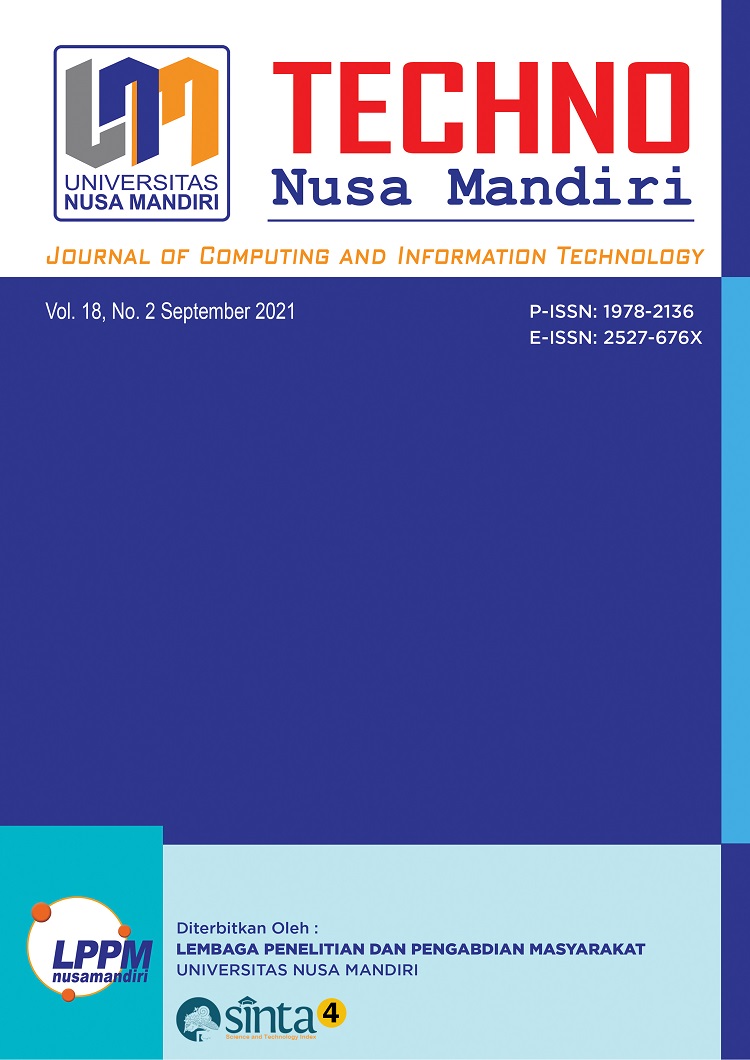ANALYSIS OF DEPRESSION IN COLLEGE STUDENT DURING COVID-19 PANDEMIC USING EXTREAM GRADIENT BOOST
ANALISIS DEPRESI PADA MAHASISWA SELAMA PANDEMI COVID-19 MENGGUNAKAN EXTREAM GRADIENT BOOST
DOI:
https://doi.org/10.33480/techno.v18i2.2399Kata Kunci:
Depression, PHQ-9, XGBoostAbstrak
The Covid-19 pandemic that spreads in Indonesia causes health, economic, and social problems in the community, including mental health. Of course, this mental health problem also hit students. Seeing these conditions, we conducted research on students of the Faculty of Computer Science, University of Singaperbangsa Karawang using the Patient Health Questionnaire-9 which measures a person's level of depression. In this study, we used Extreme Gradient Boost or XGBoost to classify students' depression tendencies. We break down the dataset into training data and testing data with 4 data sharing combinations, they are 80 : 20, 50 : 50, 90 : 10, 70 : 30. The combination of 90 : 10 data sharing has the best performance with accuracy, precision, recall, and F1-scores respectively 92.86%, 94.29%, 92.86% , and 92.06%. This method also has better performance than K-Nearest Neighbor, Random Forest, Multi Layer Perception, Support Vector Machine and Decision Tree .
Referensi
Arieska, P. K., & Herdiani, N. (2018). Pemilihan teknik sampling berdasarkan perhitungan efisiensi relatif. Jurnal Statistika, 6(2), 166–171. https://jurnal.unimus.ac.id/index.php/statistik/article/view/4322/4001
Budiastuti, Dyah & Bandur, A. (2018). Validitas Dan Reliabilitas Penelitian. Mitra Wacana Media. https://www.mitrawacanamedia.com/validitas-dan-reliabilitas-penelitian
Chen, T. et al. (2016). Xgboost: A scalable tree boosting system. In Proceedings of the 22nd Acm Sigkdd International Conference on Knowledge Discovery and Data Mining, 785–794. https://doi.org/https://doi.org/10.1145/2939672.2939785
Cherif, I. L. et al. (2019). On using eXtreme Gradient Boosting (XGBoost) Machine Learning algorithm for Home Network Traffic Classification. 2019 Wireless Days (WD), 1–6. https://doi.org/10.1109/WD.2019.8734193
Ghozali, I. (2013). Aplikasi Analisis Multivariate Dengan Program IBM SPSS 21 Update PLS Regresi. Badan Penerbit Universitas Diponegoro. https://mikroskil.ac.id/pustaka/index.php?p=show_detail&id=7026&keywords
Gullo, F. (2015). From patterns in data to knowledge discovery: What data mining can do. Physics Procedia, 62, 18–22. https://doi.org/10.1016/j.phpro.2015.02.005
Handayani, A., Jamal, A., & Septiandri, A. A. (2017). Evaluasi Tiga Jenis Algoritme Berbasis Pembelajaran Mesin untuk Klasifikasi Jenis Tumor Payudara. Jurnal Nasional Teknik Elektro Dan Teknologi Informasi (JNTETI), 6(4). https://doi.org/10.22146/jnteti.v6i4.350
Hasanah, U., Fitri, N. L., Supardi, S., & PH, L. (2020). Depression Among College Students Due to the COVID-19 Pandemic. Jurnal Keperawatan Jiwa, 8(4), 421. https://doi.org/10.26714/jkj.8.4.2020.421-424
Karo, I. M. K. et al. (2020). A Hybrid Classification Based on Machine Learning Classifiers to Predict Smart Indonesia Program. 2020 Third International Conference on Vocational Education and Electrical Engineering (ICVEE), 1–5. https://doi.org/10.1109/ICVEE50212.2020.9243195
Karo, I. M. K. et al. (2016). Spatial clustering for determining rescue shelter of flood disaster in South Bandung using CLARANS Algorithm with Polygon Dissimilarity Function. In 2016 12th International Conference on Mathematics, Statistics, and Their Applications (ICMSA), 70–75. https://doi.org/10.1109/ICMSA.2016.7954311
Kemdikbud, Pdd. (2021). Profil Perguruan Tinggi Universitas Singaperbangsa Karawang. https://pddikti.kemdikbud.go.id/data_pt/QzRENDE1QjMtOTgyRS00MDM0LUIyOUEtRUU5NDA4MDY4MUEw
Kusuma, M. D. S. et al. (2021). TINGKAT GEJALA DEPRESI PADA MAHASISWA PROGRAM STUDI SARJANA KEPERAWATAN DI INSTITUTE TEKNOLOGI DAN KESEHATAN (ITEKES) BALI. Jurnal Riset Kesehatan Nasional, 5(1), 29–34. https://doi.org/http://dx.doi.org/10.37294/jrkn.v5i1.310
Kusuma, P. D., Marchira, C. R., & Prawitasari, S. (2018). Patient health questionnaire-9 (PHQ-9) efektif Untuk mendeteksi risiko depresi postpartum. Jurnal Keperawatan Respati Yogyakarta, 5(3), 428–433.
Lempang, G. F., Walenta, W., Rahma, K. A., Retalista, N., Maluegha, F. J., & Utomo, F. I. P. (2021). Depresi Menghadapi Pandemi Covid-19 pada Masyarakat Perkotaan (Studi Literatur). Pamator Journal, 14(1), 66–71. https://doi.org/10.21107/pamator.v14i1.9854
Martin, M., & Nilawati, L. (2019). Recall dan Precision Pada Sistem Temu Kembali Informasi Online Public Access Catalogue (OPAC) di Perpustakaan. Paradigma - Jurnal Komputer Dan Informatika, 21(1), 77–84. https://doi.org/10.31294/p.v21i1.5064
Muslim, I., & Karo, K. (2020). Implementasi Metode XGBoost dan Feature Importance untuk Klasifikasi pada Kebakaran Hutan dan Lahan. Journal of Software Engineering, Information and Communication Technology, 1(1), 10–16.
Perhimpunan Dokter Spesialis Kedokteran Jiwa Indonesia. (2020). Masalah Psikologis Di Era Pandemi Covid-19. http://www.pdskji.org/home
Satuan Tugas Penanganan Covid-19. (2021). Peta Sebaran Kasus Covid-19 Di Indonesia. https://covid19.go.id/peta-sebaran
Sugiyono. (2014). Statistik untuk Penelitian (E. Mulyatiningsih (ed.)). Alfabeta. https://adoc.pub/statistik-untuk-penelitian.html
##submission.downloads##
Diterbitkan
Cara Mengutip
Terbitan
Bagian
Lisensi
The copyright of any article in the TECHNO Nusa Mandiri Journal is fully held by the author under the Creative Commons CC BY-NC license. The copyright in each article belongs to the author. Authors retain all their rights to published works, not limited to the rights set out on this page. The author acknowledges that Techno Nusa Mandiri: Journal of Computing and Information Technology (TECHNO Nusa Mandiri) is the first to publish with a Creative Commons Attribution 4.0 International license (CC BY-NC). Authors can enter articles separately, manage non-exclusive distribution, from manuscripts that have been published in this journal into another version (for example: sent to author affiliation respository, publication into books, etc.), by acknowledging that the manuscript was published for the first time in Techno Nusa Mandiri: Journal of Computing and Information Technology (TECHNO Nusa Mandiri); The author guarantees that the original article, written by the stated author, has never been published before, does not contain any statements that violate the law, does not violate the rights of others, is subject to the copyright which is exclusively held by the author. If an article was prepared jointly by more than one author, each author submitting the manuscript warrants that he has been authorized by all co-authors to agree to copyright and license notices (agreements) on their behalf, and agrees to notify the co-authors of the terms of this policy. Techno Nusa Mandiri: Journal of Computing and Information Technology (TECHNO Nusa Mandiri) will not be held responsible for anything that may have occurred due to the author's internal disputes.
















